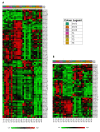The Effect of In Vitro Cultivation on the Transcriptome of Adult Brugia malayi
- PMID: 26727204
- PMCID: PMC4699822
- DOI: 10.1371/journal.pntd.0004311
The Effect of In Vitro Cultivation on the Transcriptome of Adult Brugia malayi
Abstract
Background: Filarial nematodes cause serious and debilitating infections in human populations of tropical countries, contributing to an entrenched cycle of poverty. Only one human filarial parasite, Brugia malayi, can be maintained in rodents in the laboratory setting. It has been a widely used model organism in experiments that employ culture systems, the impact of which on the worms is unknown.
Methodology/principal findings: Using Illumina RNA sequencing, we characterized changes in gene expression upon in vitro maintenance of adult B. malayi female worms at four time points: immediately upon removal from the host, immediately after receipt following shipment, and after 48 h and 5 days in liquid culture media. The dramatic environmental change and the 24 h time lapse between removal from the host and establishment in culture caused a globally dysregulated gene expression profile. We found a maximum of 562 differentially expressed genes based on pairwise comparison between time points. After an initial shock upon removal from the host and shipping, a few stress fingerprints remained after 48 h in culture and until the experiment was stopped. This was best illustrated by a strong and persistent up-regulation of several genes encoding cuticle collagens, as well as serpins.
Conclusions/significance: These findings suggest that B. malayi can be maintained in culture as a valid system for pharmacological and biological studies, at least for several days after removal from the host and adaptation to the new environment. However, genes encoding several stress indicators remained dysregulated until the experiment was stopped.
Conflict of interest statement
The authors have declared that no competing interests exist.
Figures





Similar articles
-
A deep sequencing approach to comparatively analyze the transcriptome of lifecycle stages of the filarial worm, Brugia malayi.PLoS Negl Trop Dis. 2011 Dec;5(12):e1409. doi: 10.1371/journal.pntd.0001409. Epub 2011 Dec 13. PLoS Negl Trop Dis. 2011. PMID: 22180794 Free PMC article.
-
Effects of doxycycline on gene expression in Wolbachia and Brugia malayi adult female worms in vivo.J Biomed Sci. 2012 Feb 9;19(1):21. doi: 10.1186/1423-0127-19-21. J Biomed Sci. 2012. PMID: 22321609 Free PMC article.
-
Transcription profiling reveals stage- and function-dependent expression patterns in the filarial nematode Brugia malayi.BMC Genomics. 2012 May 14;13:184. doi: 10.1186/1471-2164-13-184. BMC Genomics. 2012. PMID: 22583769 Free PMC article.
-
Defining Brugia malayi and Wolbachia symbiosis by stage-specific dual RNA-seq.PLoS Negl Trop Dis. 2017 Mar 30;11(3):e0005357. doi: 10.1371/journal.pntd.0005357. eCollection 2017 Mar. PLoS Negl Trop Dis. 2017. PMID: 28358880 Free PMC article.
-
Immune evasion genes from filarial nematodes.Int J Parasitol. 2001 Jul;31(9):889-98. doi: 10.1016/s0020-7519(01)00213-2. Int J Parasitol. 2001. PMID: 11406138 Review.
Cited by
-
Susceptibility Testing of Medically Important Parasites.Clin Microbiol Rev. 2017 Jul;30(3):647-669. doi: 10.1128/CMR.00111-16. Clin Microbiol Rev. 2017. PMID: 28446445 Free PMC article. Review.
-
Pharmacological Profiling of a Brugia malayi Muscarinic Acetylcholine Receptor as a Putative Antiparasitic Target.Antimicrob Agents Chemother. 2023 Jan 24;67(1):e0118822. doi: 10.1128/aac.01188-22. Epub 2023 Jan 5. Antimicrob Agents Chemother. 2023. PMID: 36602350 Free PMC article.
-
Profiling the macrofilaricidal effects of flubendazole on adult female Brugia malayi using RNAseq.Int J Parasitol Drugs Drug Resist. 2016 Dec;6(3):288-296. doi: 10.1016/j.ijpddr.2016.09.005. Epub 2016 Oct 1. Int J Parasitol Drugs Drug Resist. 2016. PMID: 27733308 Free PMC article.
-
Mining Filarial Genomes for Diagnostic and Therapeutic Targets.Trends Parasitol. 2018 Jan;34(1):80-90. doi: 10.1016/j.pt.2017.09.003. Epub 2017 Oct 12. Trends Parasitol. 2018. PMID: 29031509 Free PMC article. Review.
-
Dirofilariasis mouse models for heartworm preclinical research.Front Microbiol. 2023 Jun 22;14:1208301. doi: 10.3389/fmicb.2023.1208301. eCollection 2023. Front Microbiol. 2023. PMID: 37426014 Free PMC article.
References
-
- Krishna Kumari A, Harichandrakumar KT, Das LK, Krishnamoorthy K (2005) Physical and psychosocial burden due to lymphatic filariasis as perceived by patients and medical experts. Trop Med Int Health 10: 567–573. - PubMed
-
- Williams SA, Lizotte-Waniewski MR, Foster J, Guiliano D, Daub J, Scott AL, et al. (2000) The filarial genome project: analysis of the nuclear, mitochondrial and endosymbiont genomes of Brugia malayi. Int J Parasitol 30: 411–419. - PubMed
Publication types
MeSH terms
LinkOut - more resources
Full Text Sources
Other Literature Sources
Molecular Biology Databases

